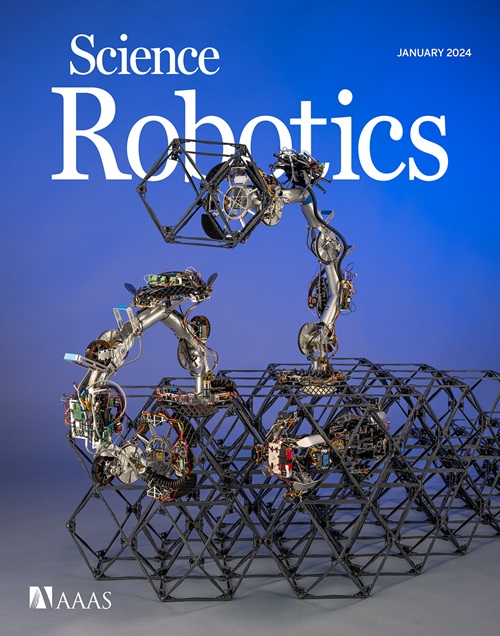粘着着陆:受昆虫启发的扑翼空中微型机器人安全着陆策略
IF 27.5
1区 计算机科学
Q1 ROBOTICS
引用次数: 0
摘要
对于飞行昆虫来说,从飞行到地面运动的过渡需要有效的着陆机动,以便在各种表面上稳定着陆。昆虫的着陆行为是多种多样的,一些昆虫使用更有控制的飞行方法着陆,而另一些昆虫则用身体的某些部分来抑制碰撞的影响。真实昆虫的着陆方法启发了我们目前的工作,我们提出了一种结合机械和控制的方法来实现扑翼微型飞行器的安全准确着陆。对于机械着陆的方法,我们从起重机苍蝇的腿中获得灵感,设计了有损柔顺的腿,在表面碰撞时最大限度地耗散能量。我们探讨了柔顺腿设计的三个特点:腿的姿势、关节的数量和关节的位置。着陆控制方法的难点在于克服地表附近的气动地面效应。利用柔顺腿在撞击过程中的设计,我们设计了预撞击行为,从昆虫的着陆轨迹中获得灵感,以提高着陆成功率。所提出的受控着陆顺序包括从悬停开始的初始加速,然后向目标减速,以非零撞击速度结束,类似于在昆虫中观察到的情况。最后,利用昆虫尺度的扑翼微型航空机器人平台(Harvard RoboBee),验证了其在自然地形上的可控、安全、准确着陆。本文章由计算机程序翻译,如有差异,请以英文原文为准。

Sticking the landing: Insect-inspired strategies for safely landing flapping-wing aerial microrobots
For flying insects, the transition from flight to surface locomotion requires effective touchdown maneuvers that allow stable landings on a variety of surfaces. Landing behaviors of insects are diverse, with some using more controlled flight approaches to landing, whereas others dampen collision impacts with parts of their bodies. The landing approaches of real insects inspired our current work, where we present a combined mechanical and control approach to achieving safe and accurate landings for flapping-wing microaerial vehicles. For the mechanical approach to landing, we took inspiration from the legs of the crane fly, designing lossy compliant legs that maximize energy dissipation during surface collisions. We explored three features in the compliant leg design: leg stance, number of joints, and joint placement. For the control approach to landing, the challenge lies in overcoming the aerodynamic ground effect near the surface. Leveraging the compliant leg design during impact, we designed the preimpact behavior, drawing inspiration from insect landing trajectories, to increase landing success. The proposed controlled landing sequence includes an initial acceleration from hovering, followed by deceleration toward the target, ending with a nonzero impact velocity, similar to what is observed in insects. Last, using an insect-scale flapping-wing aerial microrobot platform (Harvard RoboBee), we verified the controlled, safe, and accurate landing on natural terrain.
求助全文
通过发布文献求助,成功后即可免费获取论文全文。
去求助
来源期刊

Science Robotics
Mathematics-Control and Optimization
CiteScore
30.60
自引率
2.80%
发文量
83
期刊介绍:
Science Robotics publishes original, peer-reviewed, science- or engineering-based research articles that advance the field of robotics. The journal also features editor-commissioned Reviews. An international team of academic editors holds Science Robotics articles to the same high-quality standard that is the hallmark of the Science family of journals.
Sub-topics include: actuators, advanced materials, artificial Intelligence, autonomous vehicles, bio-inspired design, exoskeletons, fabrication, field robotics, human-robot interaction, humanoids, industrial robotics, kinematics, machine learning, material science, medical technology, motion planning and control, micro- and nano-robotics, multi-robot control, sensors, service robotics, social and ethical issues, soft robotics, and space, planetary and undersea exploration.
 求助内容:
求助内容: 应助结果提醒方式:
应助结果提醒方式:


